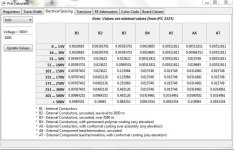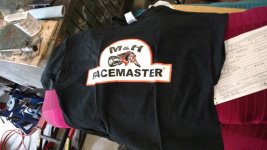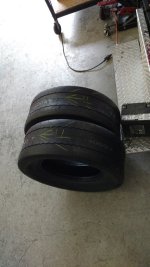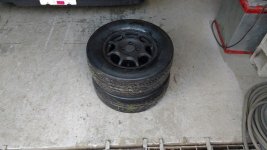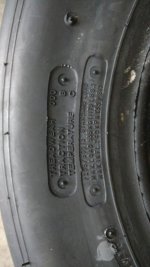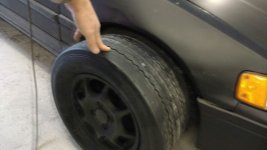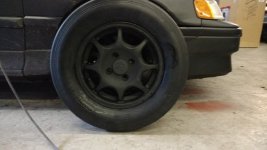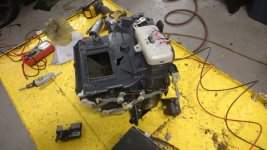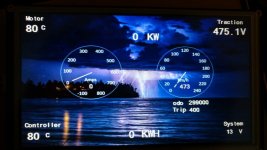I don't always drive like that and a buddy is a drifter so I got some awesome deals on any tires I wantfechter said:Very impressive. Bet the tires won't last long.
You are using an out of date browser. It may not display this or other websites correctly.
You should upgrade or use an alternative browser.
You should upgrade or use an alternative browser.
Hi power inverter for Nissan leaf motor. Dyno's 302.3hp p15
- Thread starter Arlo1
- Start date
liveforphysics said:Arlo1 said:I think you start by looking at what models come with a lsd.....Punx0r said:Any chance Nissan raided the parts bin for the Leaf's diff? I've got a feeling the answer is "no" considering how different the whole transmission is to their multi-speed ICE cars, but you never know...
Mind you I've never held or measured or anything to a LEAF differential. That said, I have installed quite a few Nissan differentials for FWD and RWD. You wouldn't expect it, but it's an enormous year-range and model range for Nissan's that can swap LSD differentials. This doesn't mean that the LEAF may not be it's own unique thing, but just as a data-point, you an swap LSD's between a BUNCH of models of Subaru and a BUNCH of models of Datusn/Nissan and a BUNCH of models of Mazda and amazingly, and over a rear-range of like 1975 to mid 2000's. They typically just need a different ring-gear bolted onto the LSD, and occasionally different sized bearings pressed on, but otherwise it's extremely handy how they basically standardized the differential on so many models across mfg's for so many decades.
I would say it's at least worth investigating what may fit for LSD in a LEAF for a street car. If it's a track car and you're on slicks, I realize this controversial and counter-intuitive to claim, but LSD or open diff makes essentially ZERO difference in a car running drag slicks on a sticky track. I couldn't tell you why exactly, but from decades of observations, an LSD or no LSD at the drag strip makes essentially no impact on torque steer or 60ft times.
On normal asphalt on normal street tires it makes a very notable difference to have an LSD.
I had it in my hand and looked around for a bit compared it to a 1990 honda accord diff I had it was much different. I could not see a Way to make something help... Even thought about adding magnets to make a eddy brake/slip type thing then realized it will attract a lot of filings to the magnets... If I can find one in time I will but in normal use you don't really notice it usualy spins both front tires and it hooks well
I know it's probably in the topic somewhere but I can't seem to find it in less than 1 minute, What are you using for batteries?
I ended up making some modules from some used EIG cells.fechter said:I know it's probably in the topic somewhere but I can't seem to find it in less than 1 minute, What are you using for batteries?
In time I want to get some REALY power dense RC lipo or something similar for drag racing. 150c is optimal but its so hard to find single cells you can use to make something good. And the GOOD RC packs are outrageously priced.
HighHopes
10 kW
- Joined
- Mar 28, 2013
- Messages
- 930
i guess that's why they good :wink:And the GOOD RC packs are outrageously priced
for our open source discussions.. the battery pack should become a topic of discussion. we want good traction packs that we can reliably get the energy out of that we want at a fair price. is that on the market? if yes, then no issue. if not then we'll need an offshoot discussion on battery pack design. maybe not today... but soon..
liveforphysics
100 TW
HighHopes said:i guess that's why they good :wink:And the GOOD RC packs are outrageously priced
for our open source discussions.. the battery pack should become a topic of discussion. we want good traction packs that we can reliably get the energy out of that we want at a fair price. is that on the market? if yes, then no issue. if not then we'll need an offshoot discussion on battery pack design. maybe not today... but soon..
I can help a bit with this. I've been so busy lately I've not had time for my own projects at all lately.
HighHopes
10 kW
- Joined
- Mar 28, 2013
- Messages
- 930
liveforphysics said:I can help a bit with this.
/thumbs up/
Tomdb
10 W
Arlo,
Could you run me through some details of your install. Since you seem to be having alot less issues with emc. Mind posting a pdf format of your schematic?
Seeing that your brain board is outside the inverter with the phase wires going into the inverter, what kind of cables do you use, shielded?
Also are you shielding the phase current sensor wires?
On your board I do not see any isolation between the IC and driver chips on your gate drivers, is this true?
Could you run me through some details of your install. Since you seem to be having alot less issues with emc. Mind posting a pdf format of your schematic?
Seeing that your brain board is outside the inverter with the phase wires going into the inverter, what kind of cables do you use, shielded?
Also are you shielding the phase current sensor wires?
On your board I do not see any isolation between the IC and driver chips on your gate drivers, is this true?
First page.Tomdb said:Arlo,
Could you run me through some details of your install. Since you seem to be having alot less issues with emc. Mind posting a pdf format of your schematic?
Seeing that your brain board is outside the inverter with the phase wires going into the inverter, what kind of cables do you use, shielded?
Also are you shielding the phase current sensor wires?
On your board I do not see any isolation between the IC and driver chips on your gate drivers, is this true?
The Drivers are optically isolated.
I use shielded ribbon cable grounded at 1 end
I made the system modular all the gate signals and current signals are in the shielded ribbon cable.
The Brain is powered by a 12v system which is isolated from the traction pack. Then fed into another isolated supply to run the brain.
I spent 2 years fighting with noise and problems just on this build alone
marcos
1 kW
- Joined
- Nov 19, 2016
- Messages
- 348
Hi Arlo,
one thing I saw in your gate drivers (leaf and gamechanger) is that you should have larger cleareances between the traction pack side and the controller side. I see 1.6 and 2mm as the shortest path in the leaf.
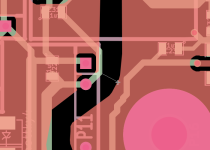
For safety concerns, medical devices for example must have 5mm cleareance and 8mm creepage for a 240V application. It can be less if the board has a lower pollution degree. A large cleareance also means less pF between the control side and the igbt side.
To avoid risks on your boards you can do some conformal coating or silicon potting to extend spacings and to improve the pollution degree. If you already do this, please make that clear in the 1st post.
On a different topic, could you share the BOM of this setup? I was looking for a suitable SMD transistor to boost the igbt driver, and I wonder which one did you use.
Thanks!
one thing I saw in your gate drivers (leaf and gamechanger) is that you should have larger cleareances between the traction pack side and the controller side. I see 1.6 and 2mm as the shortest path in the leaf.

For safety concerns, medical devices for example must have 5mm cleareance and 8mm creepage for a 240V application. It can be less if the board has a lower pollution degree. A large cleareance also means less pF between the control side and the igbt side.
To avoid risks on your boards you can do some conformal coating or silicon potting to extend spacings and to improve the pollution degree. If you already do this, please make that clear in the 1st post.
On a different topic, could you share the BOM of this setup? I was looking for a suitable SMD transistor to boost the igbt driver, and I wonder which one did you use.
Thanks!
marcos said:Hi Arlo,
one thing I saw in your gate drivers (leaf and gamechanger) is that you should have larger cleareances between the traction pack side and the controller side. I see 1.6 and 2mm as the shortest path in the leaf.
For safety concerns, medical devices for example must have 5mm cleareance and 8mm creepage for a 240V application. It can be less if the board has a lower pollution degree. A large cleareance also means less pF between the control side and the igbt side.
To avoid risks on your boards you can do some conformal coating or silicon potting to extend spacings and to improve the pollution degree. If you already do this, please make that clear in the 1st post.
8mm is a lot. The gate driver it self its only 7.5mm from the input to output side and it has a "• Safety approvals:
UL approval, 5000 VRMS for 1 minute, CSA approval,
IEC/EN/DIN-EN 60747-5-5 approval VIORM = 1414 VPEAK" So I wish you luck with 8mm. The trace you measured there is on the top and the ground plane you measured to is on the bottom so that is not a measurement of clearance.
But for the clearances I uses this chart as a loose guide.
As well the ground planes and traces are all coated from the board shop all that is exposed is the solder pads.
When done I do spray conformal coating.
Attachments
On a better note this car is about to become retarded!
I have a set of the best tires I can get for it. I will be testing with these in the spring!!! Hoping to hit a 1/4 mile track as well.
STAY TUNED!
I have a set of the best tires I can get for it. I will be testing with these in the spring!!! Hoping to hit a 1/4 mile track as well.
STAY TUNED!
Attachments
marcos
1 kW
- Joined
- Nov 19, 2016
- Messages
- 348
Indeed, it is a lot, I had a lot hair pulling because of that, but it was required to sell a particular product. You're by all means free to use the clereance you want, I'm just pointing this out as a suggestion.Arlo1 said:8mm is a lot. The gate driver it self its only 7.5mm from the input to output side and it has a "• Safety approvals:
UL approval, 5000 VRMS for 1 minute, CSA approval,
IEC/EN/DIN-EN 60747-5-5 approval VIORM = 1414 VPEAK" So I wish you luck with 8mm. The trace you measured there is on the top and the ground plane you measured to is on the bottom so that is not a measurement of clearance.
There is a quick reference for the isolation of motor drives:
http://www.ti.com/lit/wp/slyy080/slyy080.pdf
So if someone wants to comply to IEC, the minimum cleareance is 5.5mm for a reinforced isolation, unless there is a second redundant isolator in series.
About 8mm creepage, when needed, its usually acomplished cutting slots in the pcb, under the isolator for example, and even if the chip body measures 7mm, the chip creepage can be higher.
Again, its up to you, just a heads up, you dont need to comply with IEC to use your drivetrain. Its a bit reassuring when you do, though.
I have run this system with 1/4 the spacing I have now. I'm running 470v fully charged and followed all the rules that apply to my application. I am very happy with the way it is and I will not be trying to follow some weird ass impossible hospital guidline that is not related to my project. As I pointed out with 7.5mm the acpl337j is rated at 5000v for 1 minute. I only need a rating of 950v or less.....
Ohbse
10 kW
Awesome stuff Arlo, that rubber is definitely going to put the rest of the drivetrain to the test!
Still running your welded drive shafts? I'm very curious to see if they hold up to a full launch.
Getting this car dialed in will be dramatically easier than anything ICE and could potentially be insanely consistent - great for bracket racing? With gears, peaky power delivery and a clutch to modulate there's definitely a lot more to go wrong on a conventional vehicle.
Still running your welded drive shafts? I'm very curious to see if they hold up to a full launch.
Getting this car dialed in will be dramatically easier than anything ICE and could potentially be insanely consistent - great for bracket racing? With gears, peaky power delivery and a clutch to modulate there's definitely a lot more to go wrong on a conventional vehicle.
marcos
1 kW
- Joined
- Nov 19, 2016
- Messages
- 348
Nice dashboard! Is that a rpi?Arlo1 said:Working on some gauges as well.
HighHopes
10 kW
- Joined
- Mar 28, 2013
- Messages
- 930
i doubt anyone would go into production with a product like this that was not comformal coated board. also like you say slotting the board which is not a cost adder. i've designed products for high altitude (higher than commercial airplane) and the creepages were not even that bad once you took these things into consideration.
hillzofvalp
100 kW
Speaking of production...
when will you offer kits so I can put on of these in my leaf with fresh 2016 pack? I'm sure it will still be fun with a stock leaf pack... not quite as fun as 470V with 150C pack, but probably still 300% improvement.
when will you offer kits so I can put on of these in my leaf with fresh 2016 pack? I'm sure it will still be fun with a stock leaf pack... not quite as fun as 470V with 150C pack, but probably still 300% improvement.
hillzofvalp said:Speaking of production...
when will you offer kits so I can put on of these in my leaf with fresh 2016 pack? I'm sure it will still be fun with a stock leaf pack... not quite as fun as 470V with 150C pack, but probably still 300% improvement.
I suggest modifying the oem controller. If you are to remove the oem inverter it would mean you no longer have the communications with the cars CANbus and what not. This will mean none of you dash will work and most of your car would not work you would have a LOT of work to do to make the car run again. What is best is to modify the oem controller and change its programming to allow more current in the motor to a higher speed.
I do have all the parts to build up 3 kits and they are spoken for but once I get them out I will see how it goes.
One other thing is I used the OEM cap if I use a different cap it will make the bus bar layout tricky and likely mean I need to double check the gate drive tune.
hillzofvalp
100 kW
What does it take to modify the oem controller? Are you talking about a firmware rewrite?
Maybe it would be easier to remove most of the car and canbus
Maybe it would be easier to remove most of the car and canbus
It's your choice..... But the easiest way to make a leaf faster is to program it to go fasterhillzofvalp said:What does it take to modify the oem controller? Are you talking about a firmware rewrite?
Maybe it would be easier to remove most of the car and canbus
Reprogramming the OEM controller may be quite challenging without some specialized software. I'm sure somebody at Nissan has it. That would really be the ideal approach.
Another possible approach would be to "spoof" all the current sensor signals to fool the controller into giving more power. This has been done on some hybrid cars before. Basic approach would be to divide all the current sensor signals by a fixed amount so the computer sees a percentage of the actual current. The software is likely looking at the phase currents as well as the battery current and if something doesn't add up, it will trigger a fault. If all the signals are divided by the same amount, the math should be OK.
Another possible approach would be to "spoof" all the current sensor signals to fool the controller into giving more power. This has been done on some hybrid cars before. Basic approach would be to divide all the current sensor signals by a fixed amount so the computer sees a percentage of the actual current. The software is likely looking at the phase currents as well as the battery current and if something doesn't add up, it will trigger a fault. If all the signals are divided by the same amount, the math should be OK.
hillzofvalp
100 kW
I bumped into a guy a while back who claimed to have smuggled in a Nissan programmer (the laptop) and the nismo ecu etc.. said he sold it for a pretty penny stateside. Said the buyer asked complete anonymity. Wonder what the hell that guy is up to.
Similar threads
- Replies
- 65
- Views
- 13,595


